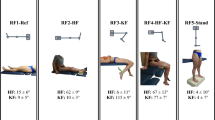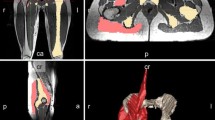Abstract
Purpose
Muscles are the primary component responsible for the locomotion and change of posture of the human body. The physiologic basis of muscle force production and movement is determined by the muscle architecture (maximum muscle force, \(F_\mathrm{o}^\mathrm{m}\), optimal muscle fiber length, \(l_\mathrm{o}^\mathrm{m}\), tendon slack length, \(l_\mathrm{s}^\mathrm{t}\), and pennation angle at optimal muscle fiber length, \(\varphi _{0}\)). The pennation angle is related to the maximum force production and to the range of motion. The aim of this study was to investigate a computational approach to calculate subject-specific pennation angle from magnetic resonance images (MRI)-based 3D anatomical model and to determine the impact of this approach on the motion analysis with personalized musculoskeletal models.
Methods
A 3D method that calculates the pennation angle using MRI was developed. The fiber orientations were automatically computed, while the muscle line of action was determined using approaches based on anatomical landmarks and on centroids of image segmentation. Three healthy male volunteers were recruited for MRI scanning and motion capture acquisition. This work evaluates the effect of subject-specific pennation angle as musculoskeletal parameter in the lower limb, focusing on the quadriceps group. A comparison was made for assessing the contribution of personalized models on motion analysis. Gait and deep squat were analyzed using neuromuscular simulations (OpenSim).
Results
The results showed variation of the pennation angle between the generic and subject-specific models, demonstrating important interindividual differences, especially for the vastus intermedius and vastus medialis muscles. The pennation angle variation between personalized and generic musculoskeletal models generated significant variation in muscle moments and forces during dynamic motion analysis.
Conclusions
A MRI-based approach to define subject-specific pennation angle was proposed and evaluated in motion analysis models. The significant differences obtained for the moments and muscle forces in quadriceps muscles indicate that a personalized approach in modeling the pennation angle can provide more individual details when investigating motion behaviors in specific subjects.






Similar content being viewed by others
References
Abe T, Kumagai K, Brechue WF (2000) Fascicle length of leg muscles is greater in sprinters than distance runners. Med Sci Sports Exerc 32(6):1125–1129
Amarantini D, Rao G, Berton E (2010) A two-step emg-and-optimization process to estimate muscle force during dynamic movement. J Biomech 43(9):1827–1830
Arnold EM, Hamner SR, Seth A, Millard M, Delp SL (2013) How muscle fiber lengths and velocities affect muscle force generation as humans walk and run at different speeds. J Exp Biol 216(11):2150–2160
Arnold EM, Ward SR, Lieber RL, Delp SL (2010) A model of the lower limb for analysis of human movement. Ann Biomed Eng 38(2):269–279
Baroni BM, Geremia JM, Rodrigues R, Azevedo Franke R, Karamanidis K, Vaz MA (2013) Muscle architecture adaptations to knee extensor eccentric training: rectus femoris vs. vastus lateralis. Muscle Nerve 48(4):498–506
Blemker SS, Asakawa DS, Gold GE, Delp SL (2007) Image-based musculoskeletal modeling: applications, advances, and future opportunities. J Magn Reson Imaging 25(2):441–451
van den Bogert AJ, Geijtenbeek T, Even-Zohar O, Steenbrink F, Hardin EC (2013) A real-time system for biomechanical analysis of human movement and muscle function. Med Biol Eng Comput 51(10):1069–1077
Bolsterlee B (2014) Subject-specific upper extremity modelling. Ph.D. thesis, TU Delft, Delft University of Technology
Buchanan TS, Lloyd DG, Manal K, Besier TF (2004) Neuromusculoskeletal modeling: estimation of muscle forces and joint moments and movements from measurements of neural command. J Appl Biomech 20(4):367
Choi HF, Blemker SS (2013) Skeletal muscle fascicle arrangements can be reconstructed using a laplacian vector field simulation. PloS One 8(10):e77,576
Choi HF, Chincisan A, Magnenat-Thalmann N (2015) A collective approach for reconstructing 3d fiber arrangements in virtual musculoskeletal soft tissue models. Computational biomechanics for medicine. Springer, Berlin, pp 117–128
CIBC (2014) Seg3D: volumetric image segmentation and visualization. Scientific Computing and Imaging Institute (SCI). http://www.seg3d.org
Delp SL, Anderson FC, Arnold AS, Loan P, Habib A, John CT, Guendelman E, Thelen DG (2007) Opensim: open-source software to create and analyze dynamic simulations of movement. Biomed Eng IEEE Trans 54(11):1940–1950
Delp SL, Loan JP, Hoy MG, Zajac FE, Topp EL, Rosen JM (1990) An interactive graphics-based model of the lower extremity to study orthopaedic surgical procedures. Biomed Eng IEEE Trans 37(8):757–767
Ema R, Wakahara T, Miyamoto N, Kanehisa H, Kawakami Y (2013) Inhomogeneous architectural changes of the quadriceps femoris induced by resistance training. Eur J Appl Physiol 113(11):2691–2703
Erskine RM (2010) The inter-individual variability in human muscle strength and in the response to resistance training. Ph.D. thesis, The Manchester Metropolitan University
Friederich JA, Brand RA (1990) Muscle fiber architecture in the human lower limb. J Biomech 23(1):91–95
Handsfield GG, Meyer CH, Hart JM, Abel MF, Blemker SS (2014) Relationships of 35 lower limb muscles to height and body mass quantified using MRI. J Biomech 47(3):631–638
Herzog W, Read L (1993) Lines of action and moment arms of the major force-carrying structures crossing the human knee joint. J Anat 182(Pt 2):213
Jensen RH, Davy DT (1975) An investigation of muscle lines of action about the hip: a centroid line approach vs the straight line approach. J Biomech 8(2):103–110
Kadaba MP, Ramakrishnan H, Wootten M (1990) Measurement of lower extremity kinematics during level walking. J Orthop Res 8(3):383–392
Karamanidis K, Adamantios A (2006) Mechanical and morphological properties of human quadriceps femoris and triceps surae muscle-tendon unit in relation to aging and running. J Biomech 39(3):406–417
Krishnan S, Dawood A, Richards R, Henckel J, Hart A (2012) A review of rapid prototyped surgical guides for patient-specific total knee replacement. J Bone Joint Surg Br 94(11):1457–1461
Lee D, Li Z, Sohail QZ, Jackson K, Fiume E, Agur A (2015) A three-dimensional approach to pennation angle estimation for human skeletal muscle. Comput Methods Biomech Biomed Eng 18(13):1474–1484
Lenaerts G, De Groote F, Demeulenaere B, Mulier M, Van der Perre G, Spaepen A, Jonkers I (2008) Subject-specific hip geometry affects predicted hip joint contact forces during gait. J Biomech 41(6):1243–1252
Lerner ZF, Board WJ, Browning RC (2014) Effects of obesity on lower extremity muscle function during walking at two speeds. Gait Posture 39(3):978–984
Lieber RL, Fridén J (2001) Clinical significance of skeletal muscle architecture. Clin Orthop Relat Res 383:140–151
Lin YC, Fok LA, Schache AG, Pandy MG (2015) Muscle coordination of support, progression and balance during stair ambulation. J Biomech 48(2):340–347
Liu MQ, Anderson FC, Schwartz MH, Delp SL (2008) Muscle contributions to support and progression over a range of walking speeds. J Biomech 41(15):3243–3252
Mow VC, Huiskes R (2005) Basic orthopaedic biomechanics and mechano-biology. Lippincott Williams & Wilkins, Philadelphia
Pandy MG, Andriacchi TP (2010) Muscle and joint function in human locomotion. Annu Rev Biomed Eng 12:401–433
Pierre A, Laurent R, Stéphane T, Jane T, Mariette Y (2014) 3D mesh generation. In: CGAL user and reference manual. CGAL Editorial Board, France. www.cgal.org
Powell PL, Roy RR, Kanim P, Bello MA, Edgerton VR (1984) Predictability of skeletal muscle tension from architectural determinations in guinea pig hindlimbs. J Appl Physiol 57(6):1715–21
Rana M, Ghassan H, James MW (2009) Automated tracking of muscle fascicle orientation in b-mode ultrasound images. J Biomech 42(13):2068–2073
Rana M, Ghassan H, James MW (2013) 3d fascicle orientations in triceps surae. J Appl Physiol 115(1):116–125
Rutherford OM, Jones DA (1992) Measurement of fibre pennation using ultrasound in the human quadriceps in vivo. Eur J Appl Physiol Occup Physiol 65(5):433–437
Scott SH, Engstrom CM, Loeb GE (1993) Morphometry of human thigh muscles. Determination of fascicle architecture by magnetic resonance imaging. J Anat 182(Pt 2):249
Sartori M, Reggiani M, Pagello E, Lloyd DG (2012) Modeling the human knee for assistive technologies. Biomed Eng IEEE Trans 59(9):2642–2649
Schenk P, Siebert T, Hiepe P, Gllmar D, Reichenbach JR, Wick C, Blickhan R, Bl M (2013) Determination of three-dimensional muscle architectures: validation of the dti-based fiber tractography method by manual digitization. J Anat 223(1):61–68
Scheys L, Desloovere K, Suetens P, Jonkers I (2011) Level of subject-specific detail in musculoskeletal models affects hip moment arm length calculation during gait in pediatric subjects with increased femoral anteversion. J Biomech 44(7):1346–1353
Scheys L, Spaepen A, Suetens P, Jonkers I (2008) Calculated moment-arm and muscle-tendon lengths during gait differ substantially using mr based versus rescaled generic lower-limb musculoskeletal models. Gait Posture 28(4):640–648
Scheys L, Van Campenhout A, Spaepen A, Suetens P, Jonkers I (2008) Personalized mr-based musculoskeletal models compared to rescaled generic models in the presence of increased femoral anteversion: effect on hip moment arm lengths. Gait Posture 28(3):358–365
Steele KM, Seth A, Hicks JL, Schwartz MS, Delp SL (2010) Muscle contributions to support and progression during single-limb stance in crouch gait. J Biomech 43(11):2099–2105
Strasser EM, Thomas D, Markus P, Michael Q, Alexandra G (2013) Association between ultrasound measurements of muscle thickness, pennation angle, echogenicity and skeletal muscle strength in the elderly. Age 35(6):2377–2388
Trezise JC (2014) Relative importance and plasticity of anatomical and neuromuscular factors affecting joint torque production. PhD diss., Edith Cowan University, Western Australia. http://ro.ecu.edu.au/theses/1407
Ward SR, Eng CM, Smallwood LH, Lieber RL (2009) Are current measurements of lower extremity muscle architecture accurate? Clin Orthop Relat Res 467(4):1074–1082
Wickiewicz TL, Roland RR, Perry LP, Edgerton VR (1983) Muscle architecture of the human lower limb. Clin Orthop Relat Res 179:275–283
Wilson NA, Sheehan FT (2010) Dynamic in vivo quadriceps lines-of-action. J Biomech 43(11):2106–2113
Acknowledgments
This work was supported by the EU FP7 Marie Curie project MultiScaleHuman under Grant No. 289897. We would like to thank the University Hospital of Geneva, Prof. Osman Ratib , Bénédicte Delattre, and Nedjma Cadi for the collaboration.
Author information
Authors and Affiliations
Corresponding author
Ethics declarations
Conflict of interest
Andra Chincisan, Karelia Tecante, Matthias Becker, Nadia Magnenat-Thalmann, Christof Hurschler, and Hon Fai Choi declare that they have no conflict of interest.
Statement of informed consent
Informed consent was obtained from all patients for being included in the study.
Rights and permissions
About this article
Cite this article
Chincisan, A., Tecante, K., Becker, M. et al. A computational approach to calculate personalized pennation angle based on MRI: effect on motion analysis. Int J CARS 11, 683–693 (2016). https://doi.org/10.1007/s11548-015-1251-9
Received:
Accepted:
Published:
Issue Date:
DOI: https://doi.org/10.1007/s11548-015-1251-9




